 |
|||||||||||||||
For the hobby of model building, the X-15 afforded numerous opportunities. Even today, new kits are still being manufactured to meet the demand to build a representation of the fastest and highest research rocket plane to ever take to the skies. Various skill levels are required, based on the complexity and scale of the kit being built. Types of material range from balsa wood, plastic, resin, and even 3D printing. Scales range from a tiny 1/175th to large 1/32nd, and beyond.
all photos this page author's collection, unless otherwise noted |
||
— The Aurora Model Kit — |
||
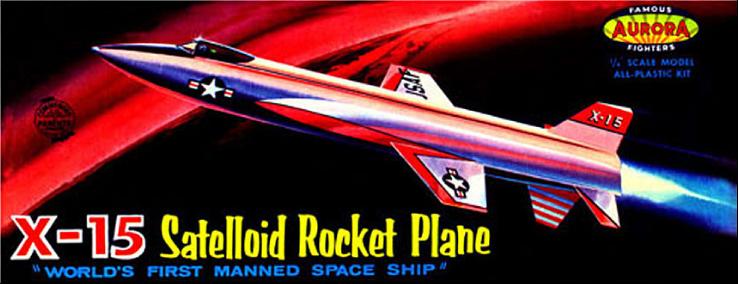 |
 |
||||||||
The first plastic model kit of the X-15 came from Aurora. As seen in the original box art above, the shape of the model bore only a passing similarity to the actual research aircraft. This came about because it was based on artwork released by Aviation Week and Space Technology (seen in the two images at right) prior to the rollout of the actual X-15. So modelmakers at the company had only those images to work with. Later versions of this kit corrected the artwork to properly reflect the real aircraft (seen below), but the kit itself never changed configuration. |
|||||||||
 |
|||||||||
 |
|||||||||
— The Revell and Monogram X-15 Kits — |
||
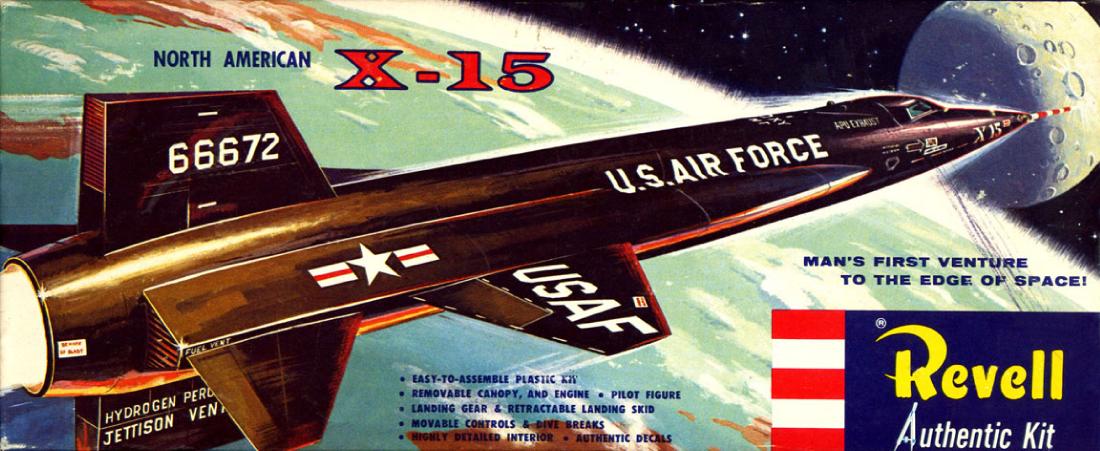 |
||
First version of the box art from the 1/64th scale Revell kit. |
||
 |
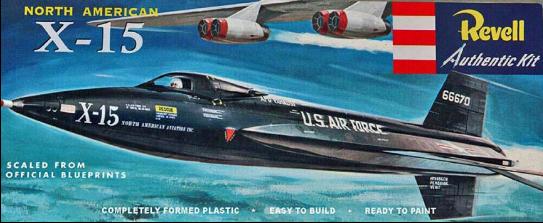 |
|||
A second version of the artwork from the 1/64th box scale Revell X-15. This is still from early in the X-15 program, when Scott Crossfield was flying test missions for North American Aviation, as noted by the lack of NASA logo on the tail, and the boom nose in place of the Q-Ball. |
||||
Box art for the B-52 with X-15 model from the Revell "Jet Command" series. Revell had what was known as "box scale" where the model scale depended on what fit into a standard box size for the kit. This kit scaled out at 1/175th. This tiny scale may be the smallest X-15 plastic model kit ever produced. |
||||
 |
||
Third version of the box art from the 1/64th Revell kit, which now incorporates the NASA tail logo and Q-Ball nose. This version of the box art lasted longer than any other. |
||
 |
||
Revell 1/64th scale X-15 built in the landing configuration for mission 2-50-89 on 18 Nov. 1966. This build has been heavily modified from the original Revell kit. Modifications include expanding the fuselage to the proper length for the X-15A-2 version of the aircraft, a model that was never released by the original Revell company. Other changes include lengthening the fuselage tunnels, and adding the nitrogen bottle behind the upper vertical tail. construction by the author |
||
 |
 |
|||
Revell disappeared for a while, and Monogram filled in the gap with a new X-15 model. This was the X-15A-2, and was released in the more common 1/72nd scale. |
In addition to the X-15A-2 in 1/72nd scale, they also released a B-52 mothership at the same scale as a combination kit. This was a huge model, and is now very rare to find. |
|||
 |
||||
The history of Revell and Monogram is convoluted. At one time they were competitors, then Monogram took over when Revell went into bankruptcy. After that, Revell was brought back as a partner under the moniker of Revell-Monogram.
Eventually, the Monogram part of the name was dropped completely, and now only Revell remains, although the original Revell kits such as the 1/64th scale X-15 and the 1/175th scale B-52/X-15 combination are now gone forever.
At least the X-15 survives in some form through the Monogram version of the plastic model kit.
The re-packaged Revell (Monogram) 1/72nd scale X-15 plastic model kit. |
||||
 |
|||||
 |
|||||
The Monogram 1/72nd kit built in configuration for mission 2-53-97 flown by Pete Knight on 3 Oct. 1967. This was the fastest rocket aircraft flight ever accomplished. construction by the author |
|||||
Detail from the artwork of the X-15 launching from the Revell 1/175th scale B-52/X-15 combination Jet Command series kit shown earlier on this page. |
|||||
— Special Hobby X-15 Kits — |
||
 |
 |
|||
One of the largest plastic kits, the Special Hobby 1/32nd scale X-15. |
A post-flight version of the X-15A-2 in 1/32nd scale with the ground handling dolly. |
|||
 |
 |
|||
A 1/48th scale version of the X-15A-2 from Special Hobby. |
Another 1/32nd scale version of the A-2. |
|||
— The Heller and Lindberg X-15 Kits — |
||
 |
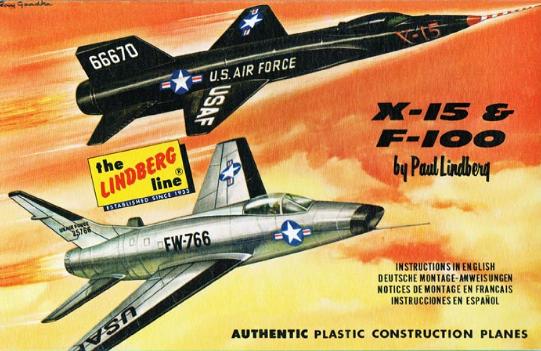 |
|||||
Lindberg model kit featuring both the X-15 and an F-100 Super Sabre chase plane. |
||||||
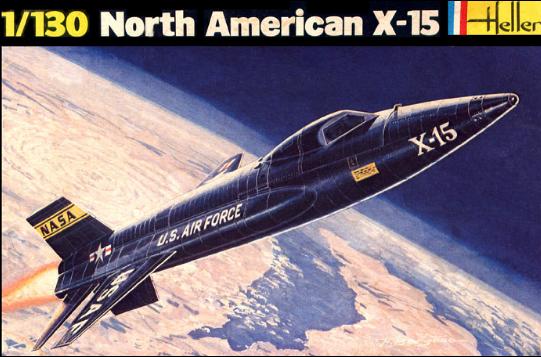 |
||||||
Early box art for the 1/130th scale Heller X-15 model kit. |
||||||
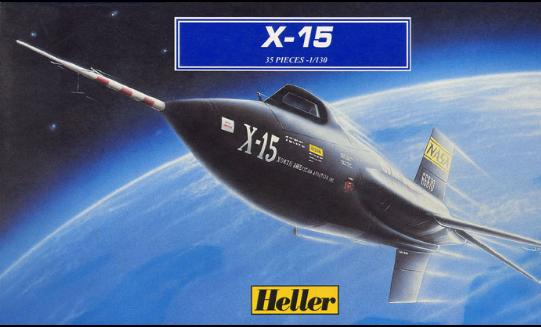 |
||||||
Two different later box art versions of the Heller X-15 kit. |
||
— Tamiya Missile Tower Kit — |
||
 |
 |
|||
Box Art of the extremely rare Missile Tower kit from Tamiya. Included is an X-15, Snark, Regulus II, and Bomarc. courtesy of JC Carbonel and Mat Irvine |
The finished kit included the X-15 and Regulus II doing a rotating high-wire act attached to a motor in the "building " underneath the Snark. courtesy of JC Carbonel and Mat Irvine |
|||
— Miscellaneous X-15 Finished Models and Kits — |
||
 |
 |
|||
Wooden display model based on a caricature of an X-15. |
||||
The Holy Grail of X-15 models: An original Topping contractor model. |
||||
 |
|||||
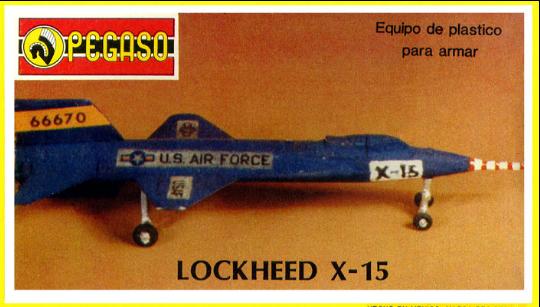 |
|||||
Dragon Models 1/144th scale "X-15 No. 2 First Flight." |
|||||
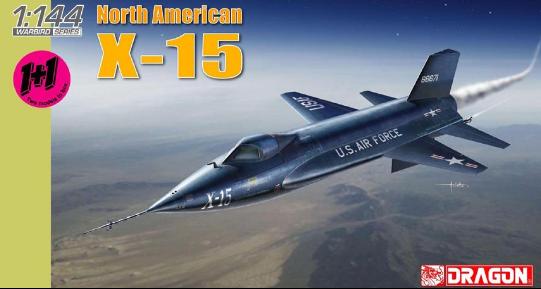 |
|||||
Pegaso X-15 1/175th scale kit manufactured in Mexico. Note X-15 is from "Lockheed." |
|||||
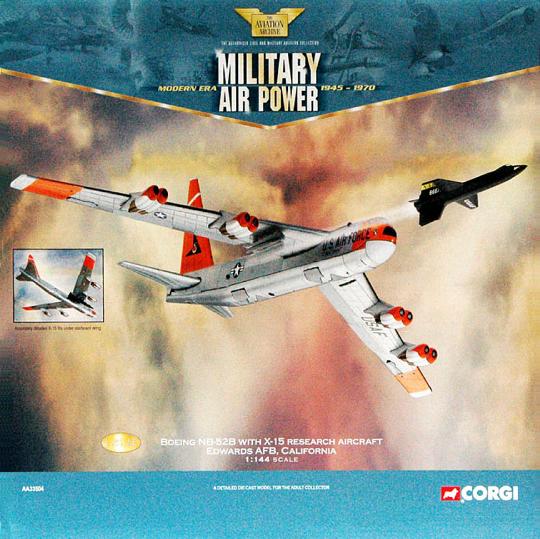 |
|||||
Different box art for the Dragon 1/144th scale "X-15 No. 2 First Flight." |
|||||
 |
|||||
Corgi highly-detailed die-cast metal 1/144th scale B-52 and X-15. |
|||||
Dragon "X-15A-2 Roll-Out." All Dragon X-15 models were available as kits or pre-built. |
||
 |
|||||
 |
|||||
A balsa wood model of the X-15 from JetEx. |
|||||
 |
|||||
The X-15 plastic model kit from Sankol. |
|||||
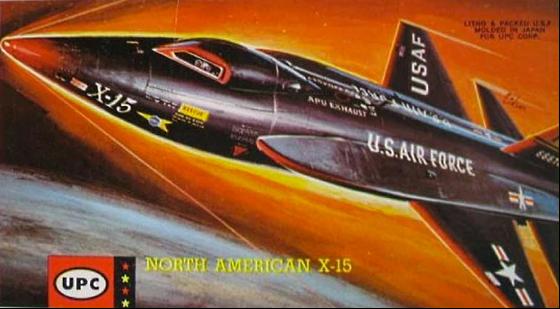 |
|||||
An HO 1/87th scale X-15 from UPC. This kit was later re-classified as being 1/100th scale. |
The 1/144th scale X Planes series included this X-15A-2. |
|||
— Paper X-15 Kits — |
||
 |
The model highlighted in the 3 photos to the left are from ecardmodels. This comes in a large 1/32nd scale, and was designed by Ken L. West. The detail is amazing, right down to the rivits and an extremely detailed cockpit. Click the link below to see David Hanner's amazing collection of X-15 paper models. |
|||||||||
 |
 |
|||||||||
 |
||||||||||
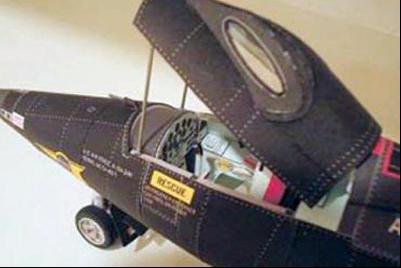 |
||||||||||
Paper model of the X-15 from Frito-Lay (center) and a more detailed paper kit (above) from Fiddler's Green. |
||||||||||
— X-15 Flying Model Rockets — |
||
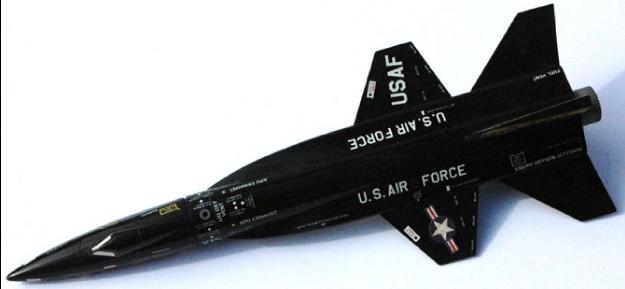 |
|||||||||||||||
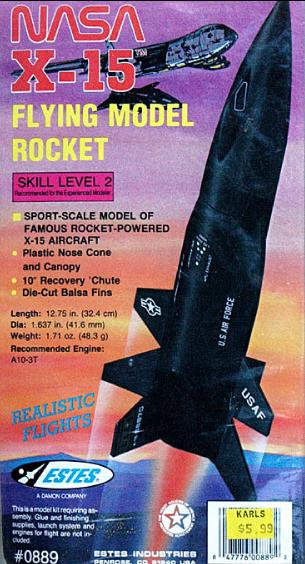 |
|||||||||||||||
 |
|||||||||||||||
Cox molded plastic flying model rocket of the X-15 from the 1970s. |
|||||||||||||||
 |
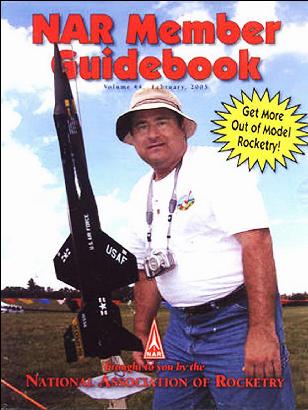 |
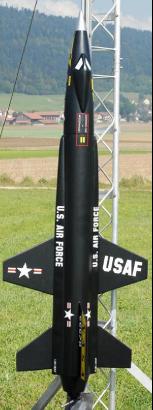 |
|||||||||||||
Estes flying rocket. |
Quest flying rocket. |
||||||||||||||
Several versions of flying X-15 model rockets. |
||
— Frank Burke's 199 X-15 Model Rocket Flights — |
||
 |
 |
|||||||||||
The three model rockets created and flown by Frank Burke. The rear model rocket (X-15 no. 1) flew 85 times, the middle model rocket (X-15 no. 2) flew 53 times, and the front model rocket (X-15 no. 3) flew 65 times), for a total of 199 flights, exactly the same as were flown by the real aircraft in the X-15 program from 1959 to 1968.
Each of these model rockets are actually rocket-powered, radio-controlled, boost gliders, which came in for landing under Frank's full control. The scale is 1/21 in order to use a standard 2.6-inch body tube and PNC 80K nosecone, leading to a 28.25-inch overall length. The wings and tail surfaces were made from a material called depron for its lightweight and easy to shape characteristics. The rocket engines used for the flights were Aerotech D13 and D24 motors. Flights were accomplished in Hillsboro, Oregon in the summer of 2022.
The design was a challenge to build for Frank, to both accurately depict the real X-15 in its proper configuration, and yet still be able to fly the vehicle under rocket power, and then with the radio control system to bring it back to the ground safely.
Under power, the rocket lifted to approximately 400 feet so that Frank could maintain good visual control of the X-15. As Frank stated at the end of the 199th flight: "Neither the airframes, radio equipment or motors ever had a single issue, a testament to their robustness. I had burned the equivalent of a small L motor, around 4000 newton-seconds. This was one of the most rewarding things I’ve done combining both rocketry and R/C aircraft."
Frank also stated: "I'd like to personally thank my son Max and my daughter Olivia for many trips to the flying field, providing launch assistance, and taking flight videos, and to Jim Wilkerson of Tahoma Photography for coming over to my club and getting excellent flight and landing photographs." |
||||||||||||
 |
 |
 |
 |
|||||||||
Frank's 1/21 scale X-15 under power. |
||||||||||||
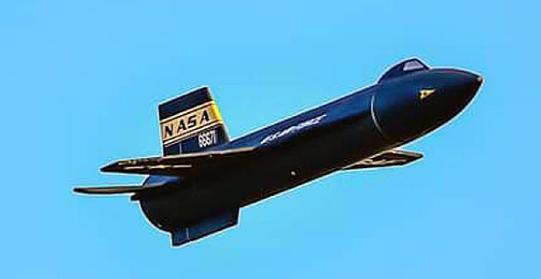 |
 |
|||
X-15 no. 2 in radio-controlled flight. |
X-15 no. 1 nearing touchdown after another successful mission. |
|||
 |
 |
|||
X-15 no. 3 gliding back (L), and less than a second from ta smooth ouchdown (R). |
||
 |
 |
|||||||||
Frank's special version of the X-15A-2, representing the two flights with the full ablative coating. To give it a bit more color, Frank used artistic license to add some details, such as the NASA tail logo and panel lines. |
||||||||||
 |
||||||||||
Frank sports his Accutron watch at the completion of Flight 199. This is the same watch that was used by the X-15 pilots when flying the program. |
||||||||||
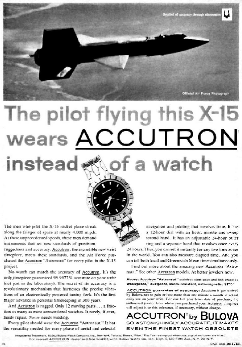 |
||||||||||
Frank visited the Michael Adams Memorial. Here he is holding his X-15 no. 1 model rocket that was flown 85 times during his homage to the X-15 program. |
||||||||||
Below: Frank fitted out a set of display external tanks to his X-15. They are attached via magnets, but are not used during an actual model rocket flight. |
||||||||||
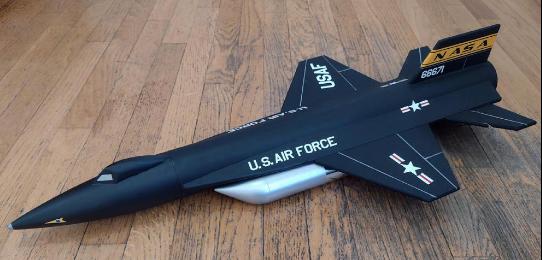 |
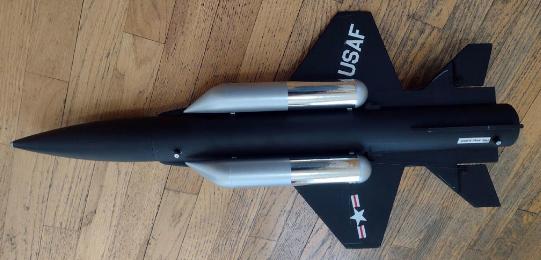 |
|||
 |
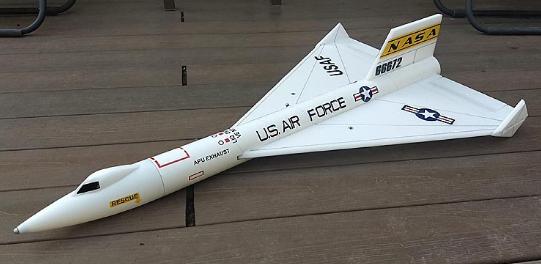 |
|||
Frank also went beyond the original X-15 program to cover what might have come after. Here are two versions of a proposed delta-wing X-15, one in standard black, and one in white as an ablative-covered version. Both are also boost glide RC model rockets. |
||
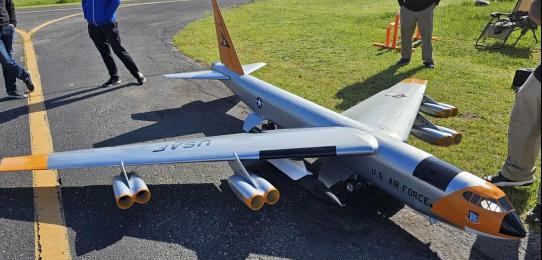 |
 |
|||
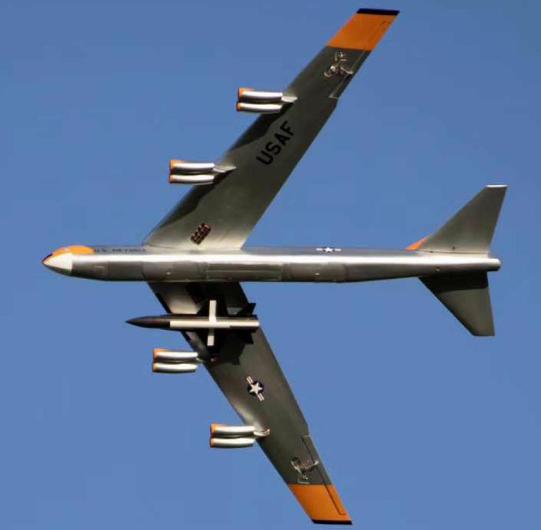 |
||||
Frank wrote me about how a customer of his, Jason Hill, bought one of Dynasoar Rocketry's 1/14th scale X-15 kits, then went on to scratch build a 1/13th scale B-52 mothership! This is an amazing feat in both rocketry and radio-controlled flight. Jason recently completed his initial rocket-powered drop tests of the X-15 in-flight from the mothership, just like the real flights during the X-15 program.
To give you an idea of how massive this B-52 is: Wingspan: 14.5 feet Length: 13 feet Weight: 85 pounds
For comparison, the X-15 is 42 inches long and weighs about 16 ounces.
To see a video of the X-15 radio-controlled rocket plane on its mission launching from this beautiful B-52 mothership, you can see it here. |
||||
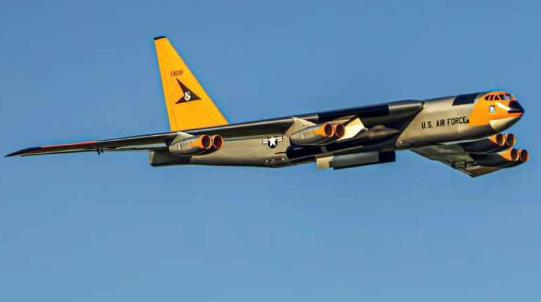 |
||||
— X-15 Shadow Box — |
||
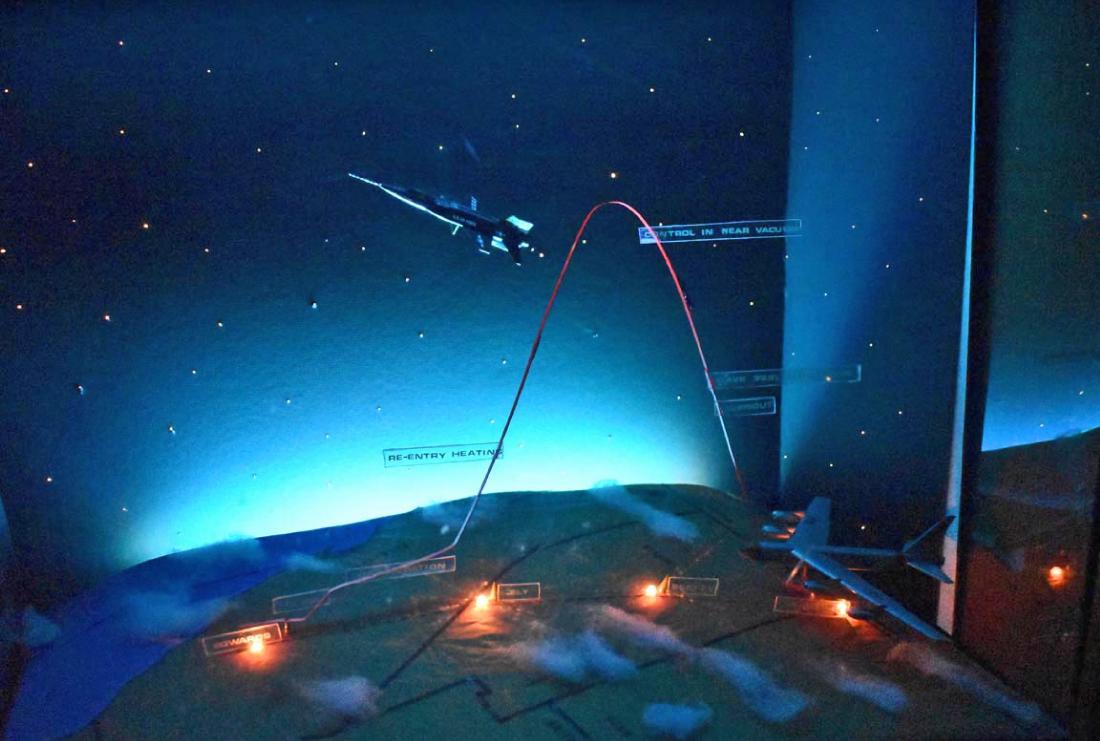 |
||
A lighted shadow box diorama created by friends (Jim Busby, Roberta Brubaker, and Andy Monsen) of the author showing the X-15 mission profile. It is a 3D rendering of the "X-15 Typical Mission" artwork from NASA (below left), and was done as a Christmas present in December 1984, soon after work began on "The X-15 Rocket Plane." They first phoned around 2:00 pm that day to say they would be coming soon with a surprise. Several phone calls later to assure that they were still on the way, they finally arrived with the completed shadowbox after 2:00 am the following morning! It was most definitely worth the wait.
Tiny fiberoptics illuminate the star background, and grain-of-wheat bulbs show the location of Edwards AFB and the High Range stations of Beatty and Ely, Nevada. The far right bulb is the upper northeast limit of the range at Wendover, Utah. A flourescent tube provides the backlighting, giving the impression of a dramatic scene at twilight. |
||
 |
 |
|||
The X-15 Mission Profile artwork re-created in 3D by Jim, Bru, and Andy. |
Detail image showing the upper reaches of the diorama. |
|||
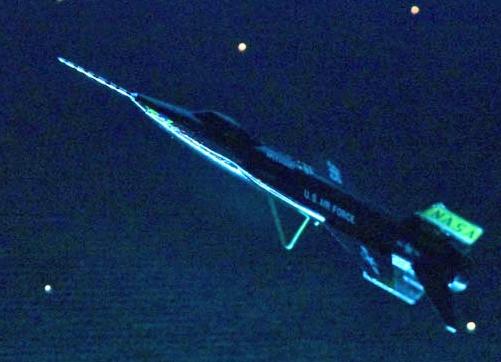 |
 |
|||||
The top of the altitude arc is painted red to illustrate the heat encountered during re-entry. The callout of "Control in Near Vacuum" highlights a program goal of the X-15. Note also the tiny X-15s mounted to the flight path ribbon. |
||||||
Close-up of the 1/144th scale X-15 at the back of the diorama. |
||||||
 |
 |
|||
The lights signifying Edwards AFB, California and Ely, Nevada. The meticulous work accomplished by Bru, Jim, and Andy, yielded one small mistake in that the two radar sites are reversed. The one shown above should be Beatty, Nevada, rather than Ely. |
||||
Another detail image showing the intricate work on a model just a few inches long. |
||||
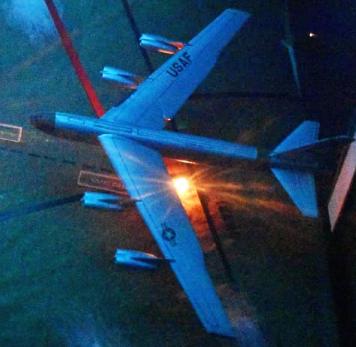 |
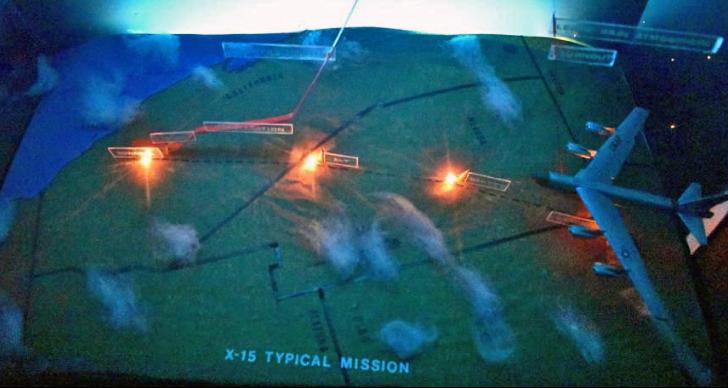 |
||||||
The B-52 mothership. Built by Jim Busby, he spent a long time even painting the tiny flight markings on the side of the B-52 that signified X-15 missions. The only problem is that they can never be seen as they are on the side of the fuselage away from the outside of the shadow box! |
|||||||
Detail showing the molded map of the southwestern United States used by the X-15 research program. It is built on an arc to show the curvature of the Earth. Also included are puffs of cotton clouds. An amazing work of art. |
|||||||